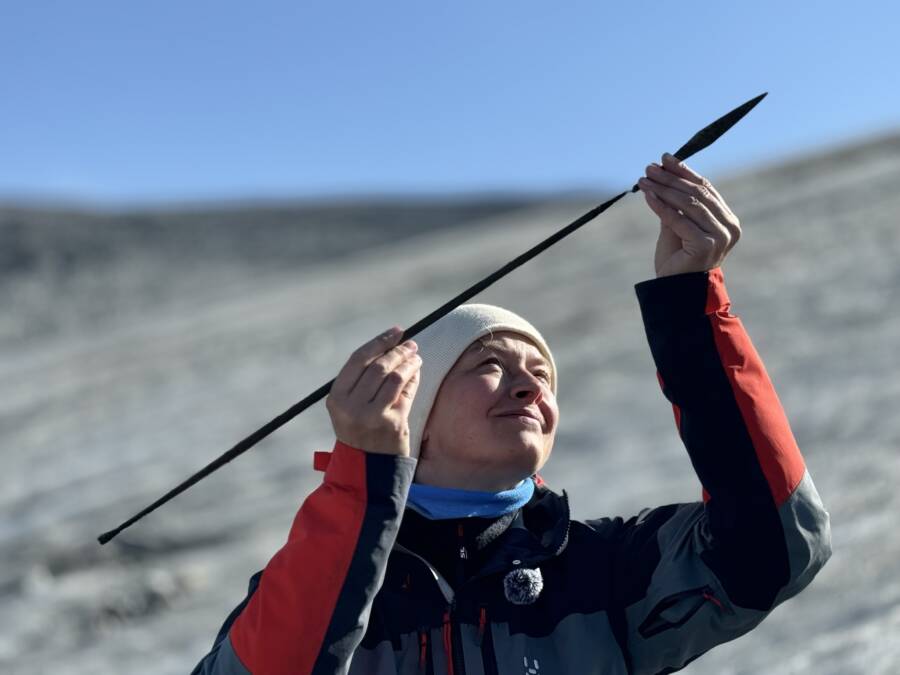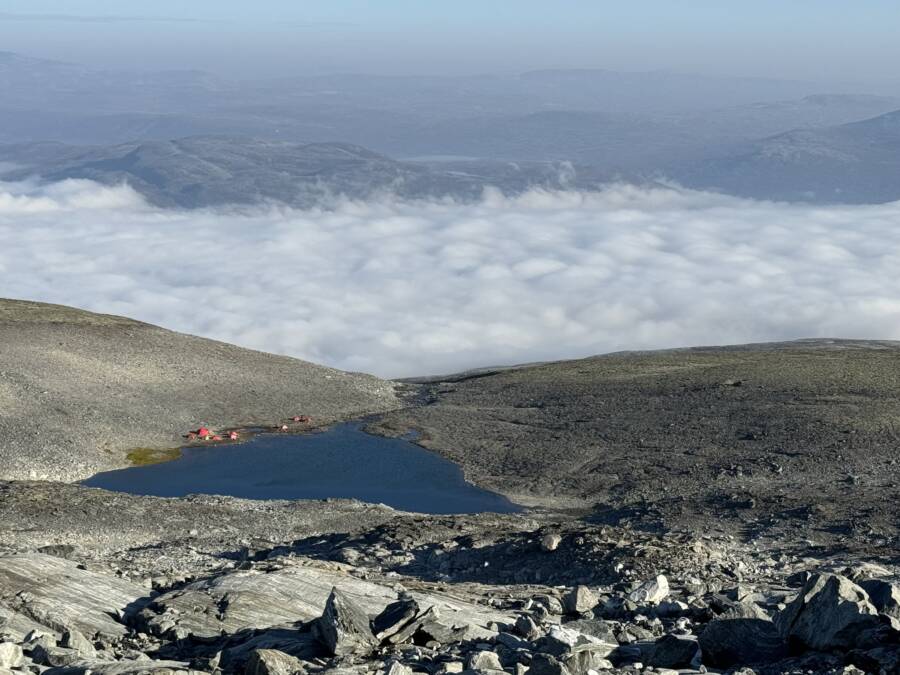Archaeologists from Secrets of the Ice noted that the arrow is an “exceptional” find, but also raised concerns about the impact of climate change on the glacier.

Secrets of the Ice/FacebookArchaeologists from Secrets of the Ice upon discovering the rare arrow lying on top of the ice.
Archaeologists just made an “incredible” find on the surface of glacial ice in Norway: a remarkably well-preserved arrow dating back 1,300 years.
This pre-Viking artifact was discovered on the Lendbreen ice patch by a team of researchers from the group Secrets of the Ice, a specialized archaeological program focused on glaciers and ice patches. Archaeologists from the team say they have made a number of exciting discoveries from the melting glaciers.
The “First Arrow Of The Year” Found Lying On The Ice
During a recent expedition at the beginning of September, glacial archaeologists came across the ancient arrow lying on the ice.

Secrets of the Ice/FacebookThe well-preserved arrow, lying on top of the ice.
Speaking with Newsweek, archaeologist Lars Holger Pilø said, “The arrow in question is incredibly well-preserved even for ice finds.”
That the arrow was found lying on the ice, Pilø said, indicates “that the melt has reached layers previously untouched by melt. So, this arrow has probably not been out of the ice since it was lost 1,300 years ago. It is frozen in time in a literal sense.”
Pilø’s team dated the arrow based on the shape of its iron arrowhead, which he says bears similarities to those found in graves dated to 700 C.E., pre-dating the Viking Age.
“We have also found a few arrows with a similar arrowhead on a few occasions,” he added, “which have come out with the same radiocarbon date.” He noted, however, that none had been in as good condition as this new one, which he described as “exceptional.”
Researchers Find A “Very, Very Rare” Type Of Arrow
The following day, the team found another arrow, dated to around 300-600 C.E. This one was notable for its three-sided arrowhead — the second of its kind ever found at the site.

Secrets of the Ice/FacebookA glacial archaeologist holding a second arrow, found in two pieces with the arrowhead and shaft detached from one another.
“[The arrow is] the type with three blades,” archaeologist Espen Finstad told Science Norway. “It’s a type of arrow that is very, very rare.”
While the arrowhead was found a couple of feet from its shaft, the “remains of sinew and pitch at the front and the fletching at the back” were remarkably still intact, according to a Facebook post from Secrets Of The Ice. Archaeologists said this discovery will be a “goldmine of information about ancient archery techniques.”
These arrows weren’t the only thing archaeologists found while exploring Lendbreen. The team also discovered ancient textiles, horse remains, and lots of frozen horse dung. Unfortunately, the researchers noted that bacteria in the dung likely would have degraded the DNA, making it impossible to analyze.
These finds, though fascinating, also carry some serious implications, as they are only made possible due to the negative impact of climate change in the region.
Climate Change Is Causing Glaciers To Melt At Alarming Rates

Secrets of the Ice/FacebookLendbreen, the glacial mountain where many discoveries have been made in light of warming temperatures.
“The emergence of archaeological finds from the retreating ice is directly linked to global warming,” Pilø told Newsweek. Reports from the International Energy Agency (IEA) show that the average annual temperature in Norway has risen by about 1.8 degrees Fahrenheit since 1900, and it shows no signs of slowing down or stopping.
“Which part of the glacier is most affected varies from year to year, depending on how the snow settles over the winter,” Finstad said.

Secrets of the Ice/FacebookArchaeologists from Secrets of the Ice with some of the artifacts they have recovered.
Secrets of the Ice’s Facebook page is highly active, with archaeologists on the team regularly responding to comments from followers. In response to one comment about humanity’s impact on climate change, as compared to a natural cycle, the archaeologists had this to say:
“In the larger picture, we have had a remarkably stable climate for many thousands of years. This is now changing due to human activities, and the melting of mountain ice is a very concrete example of what is going on.”
Projections suggest that Norway’s average temperature is expected to be roughly 8 degrees Fahrenheit higher by the end of the century than it was between 1971 and 2000. While discoveries like the arrow can be exciting and enlightening, they only further underscore the severe reality of the situation that is climate change.
As archaeologists put it: “The ice is melting, and we have to make the best of it.”